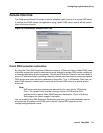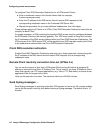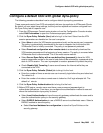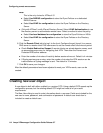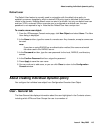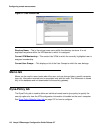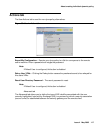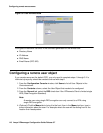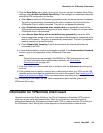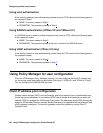
Information for VPNremote Client users
Issue 4 May 2005 119
5. Click the Dyna Policy tab to bring it to the front. If you do not want the default Dyna-Policy
settings, select Do Not Use Default Dyna-Policy. Then configure a customized method for
storing the VPN configuration for the user.
● Select None to store the VPN session parameters locally on the remote user’s computer.
The policy is automatically downloaded to the user’s computer the first time that the
VPNremote Client is initially connected. The policy is not password protected.
● Select Download configuration when remote starts to automatically download the
VPN session parameters at the beginning of every session. The policy is removed when
VPNremote client is disconnected.
● Select Secure Dyna-Policy with a user-defined key (password) to have the VPN
session parameters reside on the user’s hard disk and be activated by a password at the
start of a VPN session. The policy is automatically downloaded. The user is prompted to
create a password to protect the policy.
● Check Disable Split Tunneling if users cannot browse the Internet while they are
connected to the VPN.
6. If Local Authentication is used for authentication method, in the Authentication Password
text box, type in the a password for this VPNremote Client user.
Note:
Note: These text boxes are not available if the RADIUS or LDAP authentication is used.
For more information about authentication methods, see Dyna-Policy
Authentication tab on page 109.
7. If the User object can communicate with an extranet, click the Advanced tab to bring it to
the front.
8. If the method used to identify a remote user is different than within your VPN, use the IKE
identifier options to configure a method which is used in the extranet. See Exporting a VPN
object to an extranet on page 158 for information about connecting to an extranet.
After configuring a User object, the user name and password pairs must be given to the
VPNremote Client user.
Information for VPNremote Client users
Users who receive their Dyna-Policies by the Client Configuration Download (CCD) method
must have a user name and password pair. When trying to connect, they use the pair to
authenticate themselves. After passing authentication, CCD is used to send the Dyna-Policy to
the VPNremote Client. Which pairs to use depends on the authentication method used.



